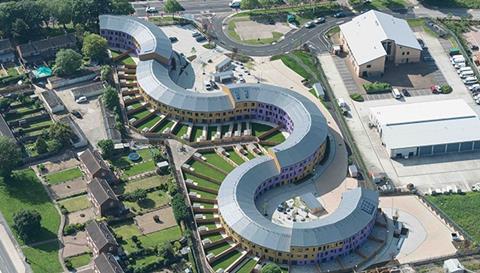Following last year’s introduction to flat roofs, this module focuses on installation and the impact of Part L 2013 on specification. It is sponsored by Sika Sarnafil

How to take this module
UBM’s CPD distance-learning programme is open to anyone seeking to develop their knowledge and skills. Each module also offers members of professional institutions an opportunity to earn between 30 and 90 minutes of credits towards their annual CPD requirement.
This article is accredited by the CPD Certification Service. To earn CPD credits, read the article and then click the link below to complete your details and answer the questions. You will receive your results instantly, and if all the questions are correctly answered, you will be able to download your CPD certificate straight away.
CPD CREDITS: 60 MINUTES
DEADLINE: 3 APRIL 2015

INTRODUCTION
The publication of Part L 2013 last April, introducing tougher energy-efficiency regulations for both domestic and non-domestic buildings, made the correct specification of single-ply roofing systems all the more crucial. This CPD will build on information provided in CPD module 2 2014,”Selecting Flat Roof Systems”, and will outline the main types of flat roof, the new requirements of Part L and the different methods of installation, as well as key aspects of the installation process.

RECAP: TYPES OF ROOF
As discussed in CPD 2 2014, there are three main options when designing a flat roof: cold, warm or inverted. However, warm roofs offer a number of benefits over the others, and this is particularly the case following the update to Part L.
Warm roofs In a warm roof, the principal thermal insulation is placed above the structural deck but below the waterproof membrane. Ventilation is not required but a vapour barrier is placed beneath the insulation to control condensation. The benefits of warm roofs include:
- The roof structure is kept warm and protected by the insulation from extremes of temperature
- There is no need to ventilate the roof space
- Upgrades to insulation is straightforward
- A variety of insulations offering different properties, such as acoustics and high density, are available depending on the application.
Cold roofs Cold roofs differ in that the principal insulation is below the structural deck and, due to the difficulty of forming an adequate vapour control layer, they require a minimum 50mm-deep ventilation path and ventilation openings in opposite sides of the roof space. However, as levels of insulation rise in line with Part L, these roofs run the risk of interstitial condensation. Moreover, the insulation and air gap required tend to be thicker than the typical joist size, and upgrading insulation at a later date is more complex, as the structural deck would need to be dismantled, and because it is difficult to ascertain how much insulation is already present.
As a result, both warranty provider NHBC and the Single Ply Roofing Association (SPRA) no longer recommend the use of cold roofs (although height restrictions, especially in domestic extensions, often dictate their use).
Inverted roofs Higher levels of insulation also pose a challenge to inverted roofs, which are ballasted either with concrete paving slabs on support pads or stone ballast, and are generally used on concrete decks. Thicker layers of insulation result in a deeper roof zone, and, because the insulation is above the waterproofing, a special filter membrane is needed to resist saturation, which would reduce the thermal performance. This is one of the factors that make inverted roofs more costly than other systems.
SPECIFICATION CONSIDERATIONS
Part L 2013 Changes introduced in April 2014 require an overall reduction in carbon dioxide emissions of an additional 6% for dwellings and 9% for non-dwellings over the previous edition of Part L. However, the limiting U-values - or thermal transmittance values - for different elements of the building are unchanged: for roofs, these remain 0.20W/m2K for new homes and 0.18W/m2K for new non-domestic buildings.
An SBEM or SAP calculation provides the required U-values for each element based on a notional building. For homes, the notional building’s roof has a default U-value of 0.13W/m2K. However, as long as the target fabric energy efficiency (TFEE) for the whole building is met, a higher thermal performance in other building elements can allow a degree of flexibility in the roof’s U-value. Typically, flat roof U-values will need to be 0.16 W/m2K or lower.
For roof refurbishment, if more than 50% of a roof area is affected, the U-value must be brought up to 0.18W/m2K.
As the performance of walls, floors, glazing and roof approach the level where further improvements provide little gain, attention is turning to detailing. This is the most significant change to the latest version of Part L. Significant increases in thermal performance can be made by improvements in airtightness and removal or reduction in the effects of thermal bridges. The communities department has published a number of Accredited Construction Details to facilitate compliance.
BIM Many manufacturers are providing BIM objects for inclusion in models. For example, Sarnafil is working with roofing contractors on objects, from full systems down to product component level. This will ultimately enable selection, estimating and ordering of materials directly from the BIM model.
Other considerations For other key specification considerations, see CPD 2 2014.
INSTALLATION
As outlined in CPD 2 2014, single-ply membranes are made of one of three materials: polyvinyl chloride (PVC), flexible polyolefin (FPO) or ethylene propylene diene monomer (EDPM). Single membranes are supplied in rolls typically 1-2m wide, so one of the most important aspects is how they are jointed. They can either be hand-welded using a hand-held hot-air welder, which operates between 280° and 380°, or machine-welded, which can weld up to three times faster.
The three most common methods of installing the membrane to the roof are outlined below:
Adhered system This system uses an adhesive to hold the membrane down. The vapour barrier is self-adhered to the deck or bonded with a cold-applied adhesive or hot bitumen. The insulation board is then bonded to the vapour barrier, again using a cold-applied adhesive (alternatively the insulation can be mechanically fastened). Adhesive is applied to the top surface of an approved insulation and the membrane is rolled into it. A heavy water-filled roller is passed over the membrane to ensure bonding between the membrane and adhesive.
Adhered systems are typically used on projects where appearance is important, as well as on smaller roof areas, concrete decks and roofs that are subject to low wind speeds. They are suitable for new-builds and refurbishments.
Mechanically fastened systems There are three common methods here: the linear bar, in-seam and spot-fix systems.
As with the adhered system, the linear bar system can be used on any deck type. A polyethylene vapour barrier is loose-laid over the deck and the insulation board is mechanically fastened using tubes, screws and washers. The number of fixings will be determined by the wind uplift calculation. Tubular fasteners are used to reduce their cold-bridging effect. The membrane is loose-laid over the insulation and a series of linear bars are fastened at centres determined by the job specific wind uplift calculation, fixed using a tube fastener and screw. The linear bar is covered with a strip of membrane that is welded to the main field sheet on both sides. This system can withstand high windloads and is suitable for new and refurbishment projects.
With the in-seam system, the membrane is again loose-laid but it is fastened at its edge with the next sheet lapping over the fasteners. This is a very quick method of installation and is very cost-effective on large roof areas. It also produces an aesthetically attractive finish and is suitable for all deck types, both new and existing.
The spot-fix system relies on attachment to special underlying insulation washers using solvent welding or induction welding. This can also be a very economical installation method for new builds or refurbishments.
Ballasted systems A typical warm ballasted roof starts with a concrete deck or a sufficiently strong alternative deck, a loose-laid vapour barrier and insulation board. The membrane is loose-laid before a protective layer of fleece membrane is laid. Paving slabs are supported and levelled using a minimum of 180mm-diameter support pads and shims. A range of finishes can be applied including pebble ballast or timber decking (subject to weight or attachment of the underlying roof system).
A green roof is a type of ballasted roof. Green roofs are divided into three main categories:
- Intensive This is an accessible roof garden. Careful design of plants and landscaping is required, as is irrigation and maintenance.
- Extensive This is lightweight, naturalistic planting that provides extensive roof cover, is suitable for new or refurbishment applications and requires minimal care, irrigation and maintenance. An extensive green roof comprises a thin layer of lightweight growing mediums, typically between 65mm and 150mm, such as grass, herbaceous, succulent and moss species that establish self-sustaining plant communities. It is suitable for use on roof slopes from 0 to 10° - pitches greater than 10° can be accommodated subject to shear force design.
- Biodiverse This is a variation on the extensive green roof type and accommodates specific environmental objectives.
The installation process
It is crucial to the success of the project that a well-controlled process of installation is in place. Look for a system provider that is active in the development and maintenance of standards, is a manufacturer member of the SPRA and has third-party accreditation.
- Installation of all systems and products must be in complete accordance with the manufacturer’s specification. Failure to comply with the specification may affect the issue of the guarantee.
- Installation must be carried out by operatives trained specifically in the use of the system. If manufacturers keep a registered list of contractors, the working relationship is closer, which can ensure high levels of on-site management, training and monitoring.
- Detail work must comply with the manufacturer’s standard details. Failure to install in compliance with standard details is one of the most common sources of problems.
- All installations should be monitored by the system provider through site inspection visits, progress inspections and a final inspection.

How to take this module
UBM’s CPD distance-learning programme is open to anyone seeking to develop their knowledge and skills. Each module also offers members of professional institutions an opportunity to earn between 30 and 90 minutes of credits towards their annual CPD requirement.
This article is accredited by the CPD Certification Service. To earn CPD credits, read the article and then click the link below to complete your details and answer the questions. You will receive your results instantly, and if all the questions are correctly answered, you will be able to download your CPD certificate straight away.
CPD CREDITS:60 MINUTES
DEADLINE: 3 APRIL 2015
Privacy policy
Information you supply to UBM Information Ltd may be used for publication and also to provide you with information about our products or services in the form of direct marketing by email, telephone, fax or post. Information may also be made available to third parties. UBM Information Ltd may send updates about Building CPD and other relevant UBM products and services. By providing your email address you consent to being contacted by email by UBM Information Ltd or other third parties. If at any time you no longer wish to receive anything from UBM Information Ltd or to have your data made available to third parties, contact the Data Protection Coordinator, UBM Information Ltd, FREEPOST LON 15637, Tonbridge, TN9 1BR, Freephone 0800 279 0357 or email ubmidpa@ubm.com. View our full privacy policy at www.building.co.uk/cpd





























No comments yet